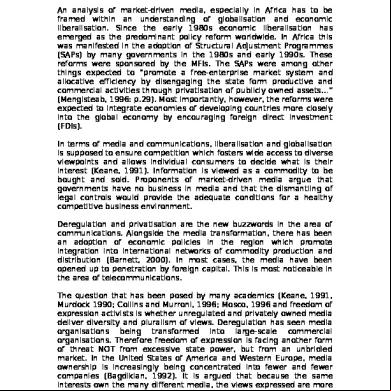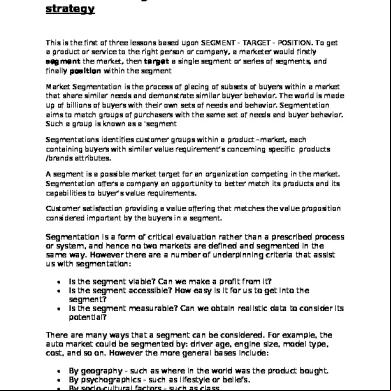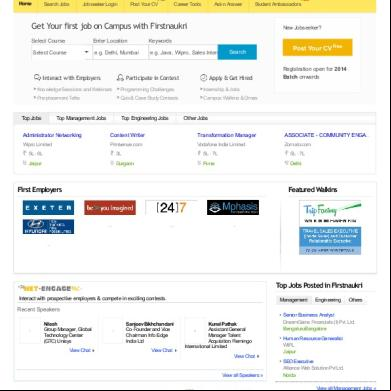Market Driven Media 2b2e50
This document was ed by and they confirmed that they have the permission to share it. If you are author or own the copyright of this book, please report to us by using this report form. Report 3b7i
Overview 3e4r5l
& View Market Driven Media as PDF for free.
More details w3441
- Words: 691
- Pages: 2
MARKET-DRIVEN MEDIA An analysis of market-driven media, especially in Africa has to be framed within an understanding of globalisation and economic liberalisation. Since the early 1980s economic liberalisation has emerged as the predominant policy reform worldwide. In Africa this was manifested in the adoption of Structural Adjustment Programmes (SAPs) by many governments in the 1980s and early 1990s. These reforms were sponsored by the MFIs. The SAPs were among other things expected to “promote a free-enterprise market system and allocative efficiency by disengaging the state form productive and commercial activities through privatisation of publicly owned assets…” (Mengisteab, 1996: p.29). Most importantly, however, the reforms were expected to integrate economies of developing countries more closely into the global economy by encouraging foreign direct investment (FDIs). In of media and communications, liberalisation and globalisation is supposed to ensure competition which fosters wide access to diverse viewpoints and allows individual consumers to decide what is their interest (Keane, 1991). Information is viewed as a commodity to be bought and sold. Proponents of market-driven media argue that governments have no business in media and that the dismantling of legal controls would provide the adequate conditions for a healthy competitive business environment. Deregulation and privatisation are the new buzzwords in the area of communications. Alongside the media transformation, there has been an adoption of economic policies in the region which promote integration into international networks of commodity production and distribution (Barnett, 2000). In most cases, the media have been opened up to penetration by foreign capital. This is most noticeable in the area of telecommunications. The question that has been posed by many academics (Keane, 1991, Murdock 1990; Collins and Murroni, 1996; Mosco, 1996 and freedom of expression activists is whether unregulated and privately owned media deliver diversity and pluralism of views. Deregulation has seen media organisations being transformed into large-scale commercial organisations. Therefore freedom of expression is facing another form of threat NOT from excessive state power, but from an unbridled market. In the United States of America and Western Europe, media ownership is increasingly being concentrated into fewer and fewer companies (Bagdikian, 1992). It is argued that because the same interests own the many different media, the views expressed are more or less the same. This has reduced diversity and pluralism of views.
Murdock (1990) has argued that competition does not promote diversity of views- “more does not mean different”. It just means the same basic commodity appearing in different formats (Barker and Minnie, 2000). In Southern Africa, South Africa gives the best example of media monopoly and conglomeration. It is difficult for new titles to penetrate the media market. When it comes to broadcasting, African governments have been reluctant to liberalise. Radio in Africa reaches the majority of people as it breaks geographical and linguistic barriers. Most African governments want to control the flow of information and as a result are reticent about opening up the airwaves to other players. However economic, political and technological pressures have forced many governments to deregulate the broadcasting sector. What has happened is that most government have commercialised and not necessarily opened up the airwaves. Several forms of broadcast liberalisation exist in the region and indeed Africa –the main form is that channels on public owned broadcasters are leased to private companies. Paterson (2000) has argued that this “permits governments to reduce their financial burden by turning money losing channels into money earners, while maintaining a significant degree of influence over programme content…” (p.7). The best example of this is in Zimbabwe when in 1997 the cash-strapped Zimbabwe Broadcasting Corporation (ZBC) leased its money-losing channel 2 to three private broadcasters – Joy TV; LDM TV and MABC. It is also obvious that commercialisation of the public media has reduced informative and educational programmes. In most cases, time devoted to news and public affairs has been reduced. There has been a proliferation of programme content consisting sports, American movies, European and American newscasts such as BBC; SKY News and CNN (Paterson, 2000). In many African countries, the advent of liberalisation has seen the demise of public service broadcasting in favour of new private and commercial broadcasting stations.
Murdock (1990) has argued that competition does not promote diversity of views- “more does not mean different”. It just means the same basic commodity appearing in different formats (Barker and Minnie, 2000). In Southern Africa, South Africa gives the best example of media monopoly and conglomeration. It is difficult for new titles to penetrate the media market. When it comes to broadcasting, African governments have been reluctant to liberalise. Radio in Africa reaches the majority of people as it breaks geographical and linguistic barriers. Most African governments want to control the flow of information and as a result are reticent about opening up the airwaves to other players. However economic, political and technological pressures have forced many governments to deregulate the broadcasting sector. What has happened is that most government have commercialised and not necessarily opened up the airwaves. Several forms of broadcast liberalisation exist in the region and indeed Africa –the main form is that channels on public owned broadcasters are leased to private companies. Paterson (2000) has argued that this “permits governments to reduce their financial burden by turning money losing channels into money earners, while maintaining a significant degree of influence over programme content…” (p.7). The best example of this is in Zimbabwe when in 1997 the cash-strapped Zimbabwe Broadcasting Corporation (ZBC) leased its money-losing channel 2 to three private broadcasters – Joy TV; LDM TV and MABC. It is also obvious that commercialisation of the public media has reduced informative and educational programmes. In most cases, time devoted to news and public affairs has been reduced. There has been a proliferation of programme content consisting sports, American movies, European and American newscasts such as BBC; SKY News and CNN (Paterson, 2000). In many African countries, the advent of liberalisation has seen the demise of public service broadcasting in favour of new private and commercial broadcasting stations.










